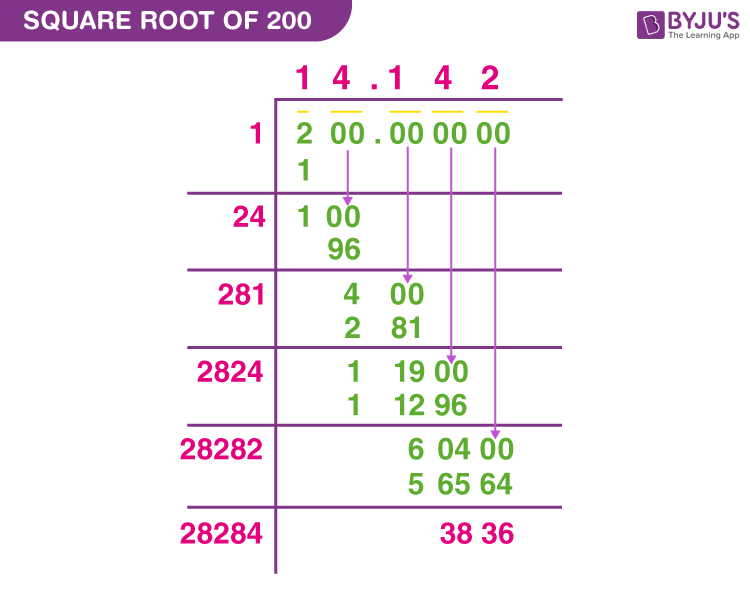The square root of 200 is a number that produces the original number 200, when multiplied by itself twice. The square root of 200 is an irrational number since it cannot be defined in the form p/q. We’ll look at two techniques for determining the square root of 200 in this article, including the long division method and the prime factorization method, with comprehensive explanations for each.
|
Square root of 200 in Radical Form, √200 = ±10√2 Or In Decimal Form, √200 = 14.14213 Or In Exponent Form, (200)½ = 14.14213 |
What is the Square Root of 200?
The square root of 200 is the result of multiplying a number by itself. Symbolically, the square root of 200 is represented as √200.
So, √200 = √(Number×Number)
Thus, if we multiply 14.142 twice, the original number 200 is obtained.
(.e.) √200 = √(14.142 × 14.142)
√200 = √(14.142)2
On cancelling the square and square root, we get
√200 = ±14.142
|
Square Root of 200 in Decimal Form: 14.142 |
Square Root of 200 in Radical Form
The square root of 200 in its simplest radical form is 10√2. If we know the prime factorization of a number, we can write the radical form of the square root of that number. As a result, the prime factorization of 200 is 2 × 2 × 2 × 5 × 5. As a result, the square root of 200 in the simplest radical form should be 10√2.
|
Square Root of 200 in Radical Form: 10√2. |
Square Root of 200 by the Prime Factorization Method
The prime factorization method can be used to find the square root of 200. We’ll need to know the prime factorization of 200 to figure out the answer. As a result, the prime factorization of the number 200 is 2 × 2 × 2 × 5 × 5.
Hence, √200 = √(2 × 2 × 2 × 5 × 5)
√200 = (√2)2× (√5)2× √2
√200 = 10√2
We know that √2 = 1.414.
Now, substitute the value in the above equation, we get
√200 = 14.14
Therefore, the square root of 200 is approximately equal to 14.14.
Square Root of 200 by the Long Division Method
Step 1: Write the number 200 in decimal form as 200.000000. Now, in pairs, couple the numbers from the right. On the left, we have 2. Find a number that equals 2 or less, when multiplied by itself.
Step 2: As a result, 1 = 1×1, which is less than 2. Now, 1 is subtracted from 2. As a result, the remainder equals 1 and the quotient equals 1. Bring one pair of zeros now. As a result, the new dividend is 100.
Step 3: We obtain 2 when we multiply the quotient by two. Create a new divisor of 20. Choose a number that is less than 100 when added to 20 and multiplied by the result.
Step 4: Adding 4 to 20 gives us 24, and 24×4 equals 96. We got 4 as the leftover after subtracting 96 from 100. Bring down the next two zeros. As a result, the new dividend is 400.
Step 5: Multiply 14 by two and we get the number 28. Create a new divisor of 280. Choose a number that equals or is less than 400 when added to 280 and multiplied by the sum.
Step 6: We see that 1 + 280 = 281 and that 281×1 = 281. Subtract 281 from 400 to get the remaining 119. Again bring down the following two zeros. So, 11900 is the new dividend.
Step 7: Continue dividing until the approximate value of the square root of 200 is obtained.
Step 8: As a result, the square root of 200 has a value of approximately 14.142.

| Related Articles: |
Video Lessons on Square Roots
Visualising square roots

Finding Square roots

Solved Examples
Example 1:
Simplify 25 + √200.
Solution:
Given: 25 + √200
As we know that the square root of 200 is 14.142.
Putting the value in the expression,
25 + √200 = 25+14.142
25 + √200 = 39.142
Hence, the simplified form of 25 + √200 is 39.142.
Example 2:
Compute the value of m, if √200m = 28.284
Solution:
Given: √200m = 28.284. …(1)
We know that √200 = 14.142
Now, substitute the value in equation (1), we get
14.142m = 28.284
m = 28.284/14.142
m = 2.
Hence, the value of m is 2.
Example 3:
Simplify the expression: (5√200 × 10√2)+12
Solution:
Given expression: (5√200 × 10√2)+12
We know that the square root of 200 in the simplest radical form is 10√2
(5√200 × 10√2)+12 = (5 ×10√2 × 10√2)+12
(5√200 × 10√2)+12 = (50√2 × 10√2)+12
(5√200 × 10√2)+12 = (500×2)+ 12
(5√200 × 10√2)+12 = 1000+12
(5√200 × 10√2)+12 = 1012
Hence, (5√200 × 10√2)+12 is 1012.
Keep checking our BYJU’S – The Learning App for more problems on square and square root of numbers, and other Maths topics, and download the app to watch a range of interesting videos.
Frequently Asked Questions on the Square Root of 200
What does the square root of 200 equal?
The value of the number √200 is 14.142.
How does the square root of 200 look like in radical form?
The radical form of the square root of 200 is 10√2.
Is the number 200 a perfect square?
No, 200 is not a perfect square, as it cannot be expressed as the product of two equal numbers.
Calculate the square of √200.
The square of the square root of 200 has a value of 200.
(In other words, √(200)2 equals 200.)
What is 5 plus the square root of 200?
We already know that √200 is 14.142.
So, 5+14.142=19.142.
Comments